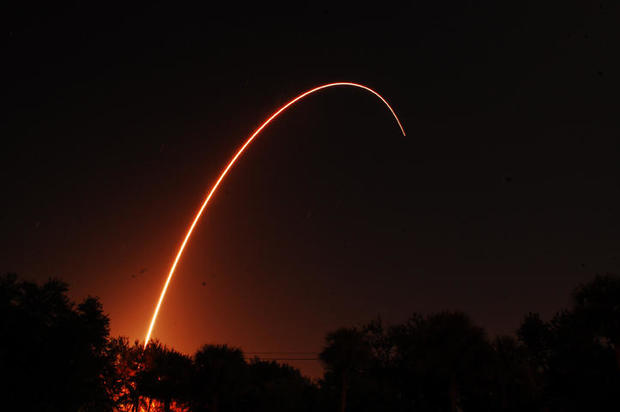Delta 4 rocket launches space surveillance satellites
By the light of a nearly full moon, a United Launch Alliance Delta 4 rocket thundered to life and climbed away from Cape Canaveral early Friday, putting on a spectacular overnight show as it boosted a pair of military space surveillance satellites toward orbit.
While the identity of the satellites and their general nature were not classified, ULA ended its launch video and commentary less than five minutes after liftoff, “at our customer’s request,” and the rest of the climb to orbit was carried out in secrecy.
This was the second launch of two Geosynchronous Space Situational Awareness Program, or GSSAP, satellites following an initial launching of two such spacecraft in 2014.
The satellites, built by Orbital ATK, are designed to operate just above and below the 22,300-mile-high geosynchronous altitude favored by communications stations, electronic eavesdropping spysats, weather satellites and other high-value spacecraft. At that altitude, it takes satellites 24 hours to complete one orbit and they appear to hang stationary in the sky.
The first two satellites “have performed remarkably well,” Lt. Gen. Samuel Greaves, commander of the Air Force Space and Missile Systems Center at Los Angeles Air Force Base in El Segundo, Calif., said in a statement Thursday.
“These next two satellites will add to that capability and enable us to understand more completely what occurs in the geosynchronous orbit to a very high quality. It’s a key piece in the puzzle for space situational awareness.”
Congressional testimony by Douglas Loverro, deputy assistant secretary of defense for space policy, said in 2014 that the GSSAP satellites are able to “survey objects in the GEO belt and allow us both to track known objects and debris and to monitor potential threats that may be aimed at this critically important region. In short, threats can no longer hide in deep space.”
Loverro said the decision to declassify and openly talk about the GSSAP system was straight forward.
“We need to monitor what happens 22,000 miles above the Earth, and we want to make sure that everyone knows we can do so,” he told a subcommittee of the Senate Committee on Armed Services.
“We believe that such efforts add immeasurably to both the safety of space flight and the stability that derives from the ability to attribute actions -- to the benefit of all space-faring nations and all who rely on space-based services.”
Earlier this summer, one of the first two GSSAPs apparently was used to inspect a military communications satellite launched in June that is now stranded in a useless orbit. A malfunction of some sort has prevented on-board thrusters from circularizing the satellite’s initially elliptical orbit at geosynchronous altitude.
The GSSAP apparently was commanded to inspect and presumably photograph the MUOS 5 communications satellite near the high point of its orbit, but the results have not been discussed and it’s not known what, if anything, might be done to help the stranded satellite.
But according to Space News, Gen. John Hyten, director of Air Force Space Command, said last year that the GSSAP satellites had captured “truly eye watering” images of other spacecraft and similar imagery of MUOS 5 may have been sent down to troubleshooters.
While the general thrust of the GSSAP program is unclassified, operational details are, and Friday’s launching provided no additional details.
The mission began at 12:52 a.m. EDT (GMT-4) when the 206-foot-tall Delta 4’s hydrogen-fueled Aerojet-Rocketdyne RS-68A main engine roared to life with a burst of fiery exhaust, followed an instant later by ignition of two strap-on solid-fuel boosters.
Trailing a brilliant plume of fiery exhaust visible for miles around, the Delta 4 quickly climbed away from launch complex 37 at the Cape Canaveral Air Force Station atop 1.2 million pounds of thrust, arcing away on an easterly trajectory over the Atlantic Ocean.
The early moments of the flight appeared normal and the solid fuel boosters burned out and fell away about a minute and 33 seconds after liftoff. The first stage followed suit two-and-a-half-minutes later and the rocket continued toward space under the power of a single hydrogen-fueled Pratt & Whitney Rocketdyne RL10B-2 engine.
United Launch Alliance ended video coverage and commentary four-and-a-half minutes into flight, well before the satellite payload reached orbit. But up to that point, there were no apparent problems.

